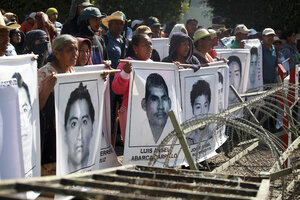Mexico: Scientists challenge claim that 43 students burned at dump
The case of 43 teacher's college students abducted in Iguala and assumed murdered has gripped Mexico for months. Two scientists say that due to space and fuel constraints, the government's theory doesn't add up.

In this Dec. 18, 2014 file photo, relatives of missing students protest in front of the entrance to the 27th Infantry Battalion base in Iguala, Mexico. Mexican authorities announced Tuesday, Jan. 13, 2015, that the parents of the 43 missing students can enter army bases to search for their sons, but say there is no evidence the army was involved in their disappearance.
AP/Felix Marquez
Mexico City
If a pyre were built to incinerate 43 bodies, how many tons of wood would be needed?
It’s a question that physicist Jorge Montemayor and materials scientist Pablo Ugalde have given thought to, and they have a precise answer: 33 tons. If tires were used for the pyre, 995 tons would be needed for incineration of all the bodies, they add.
The two scientists are among those seriously questioning Mexican government theories about the disappearance and apparent murder of 43 teaching-college students nearly four months ago, an atrocity still roiling Mexico.
Mexico’s senior criminal investigator offered a recap of the probe earlier this month, saying 97 people have been arrested for links to the roundup of the students, who were detained Sept. 26 by municipal police in the city of Iguala. Police later turned over the victims to gangsters, who incinerated them in a massive pyre, officials say.
“All lines of investigation have been exhausted,” Tomás Zerón de Lucio, head of the criminal-investigations bureau of the attorney general’s office, said Tuesday.
His summation was found wanting by relatives of the students, some social activists and a few scientists, who are demanding that the criminal investigation be expanded to include activities at the 27th Infantry Battalion base in Iguala.
Relatives of the students say they want to see whether the army battalion houses a crematorium. Interior Secretary Miguel Ángel Osorio Chong said Thursday that the parents would be allowed onto the base soon.
Attorney General’s account challenged
Montemayor and Ugalde waited more than a month before challenging Attorney General Jesús Murillo Karam’s account that the students’ bodies had been burned in a giant pyre at a garbage dump near Cocula, a town near Iguala.
The attorney general said two gang members had confessed to taking part in the incineration, which they said took more than 15 hours.
“They assigned guards in shifts to make sure the fire lasted for hours, throwing diesel, gasoline, tires, wood and plastic” on the flames, Murillo Karam said. He said temperatures had reached up to 2,900 degrees Fahrenheit. In interviews Friday, Montemayor and Ugalde said the students’ bodies couldn’t have been turned to ash and bone fragments at the Cocula dump.
“They might have cremated 10 people but not 40 or more,” said Montemayor, a physicist at the National Autonomous University of Mexico.
For one thing, the area where the earth shows evidence of fire is too small: 26 feet across. “It’s a tenth of what they would have needed to burn all the bodies,” Montemayor said.
For another, the amount of fuel needed to generate temperatures higher than 1,400 degrees F for incineration would have been enormous.
“You would have needed two trailer beds full of wood,” he said. He added that the area around the dump, at the lower end of a ravine, showed no signs that trees had been felled to feed an enormous fire, or of ashes that a giant fire would have created.
Montemayor said that whatever fuel had been used — perhaps thousands of gallons of diesel — would have demanded a large number of men to transport it, and then build and feed the pyre. Such a pyre wouldn’t have fit in the confines of the dump.
Ugalde, an engineer and scientist who studies materials combustion at the Autonomous Metropolitan University in the capital, said incinerated tires would have left more than 2 tons of steel belts and wire, which were not found.
“If they didn’t use this quantity of wood or this quantity of tires, then it’s probable that (natural) gas was used. And who uses natural gas? Crematories,” Ugalde said.
Feeding mistrust
Their arguments, which they first advanced last month in a little-noticed paper, have fed mistrust of the federal investigation among Mexicans already inclined to believe authorities are seeking a scapegoat.
Among those arrested in the case are former Iguala Mayor José Luis Abarca and his wife, María de los Ángeles Pineda, who allegedly used the municipal police force on behalf of the United Warriors criminal gang. The latest arrest in the case came late Thursday, when police in Morelos state detained Felipe Rodríguez Salgado, alias “El Cepillo,” or The Brush, an alleged hit man for the group.
The attorney general said Dec. 7 that a charred fragment of an eye socket, pulled from a river near the Cocula dump, had been identified through DNA testing at an Austrian laboratory as belonging to Alexander Mora Venancio, one of the missing students. No other students’ remains have been identified.
Osorio Chong, the interior secretary, who concurred with demands that family members and investigators from the National Commission on Human Rights be allowed onto the 27th Infantry Battalion base in Iguala, rejected attempts to ensnare the army in the case.
Army leaders have said soldiers at the base remained inside on Sept. 26 despite repeated shooting in the streets nearby.

